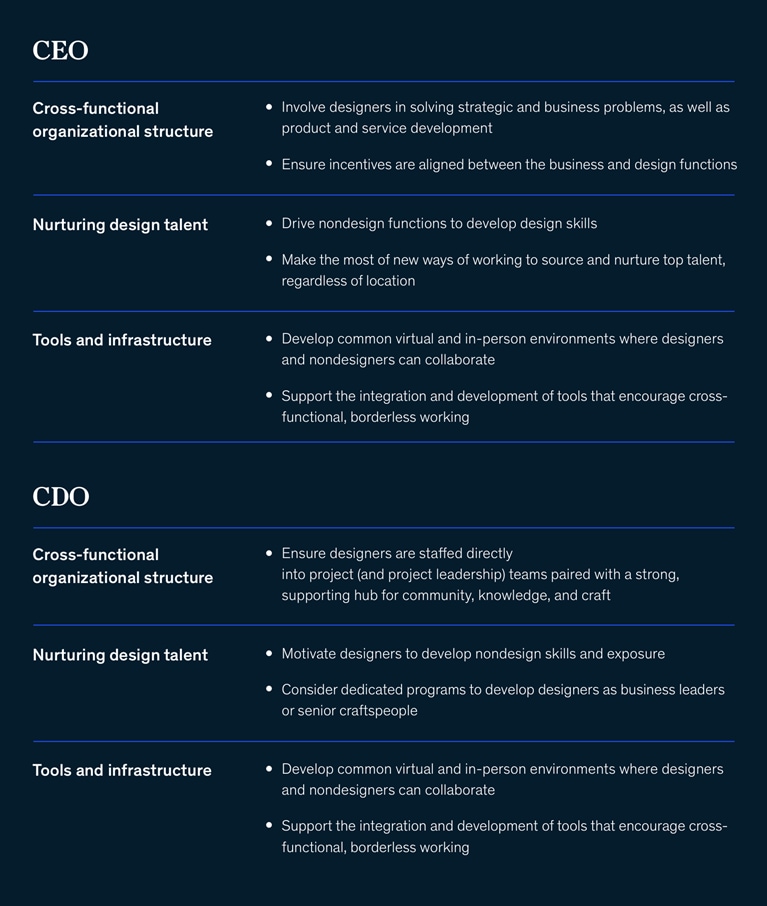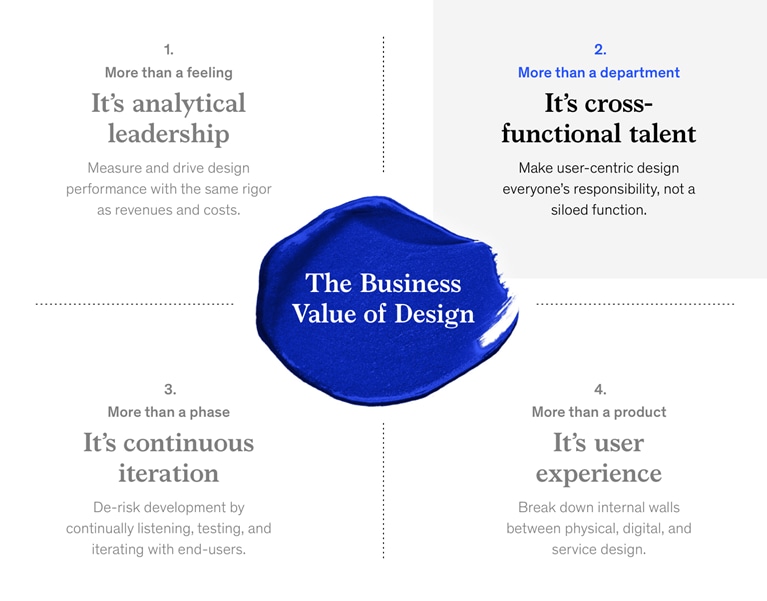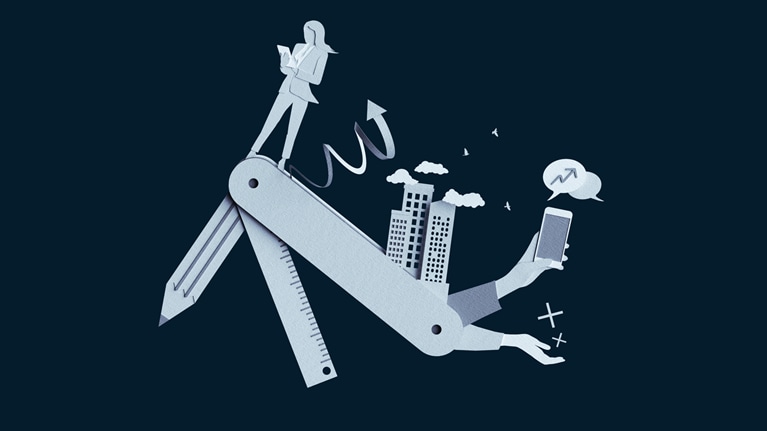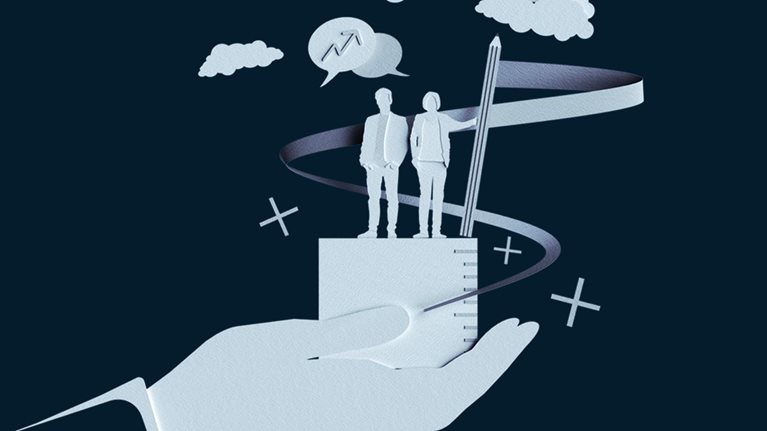An old warehouse in the trendy part of town. Swipe-card access restricted to designers only. Translucent walls covered with sticky notes. A ludicrously expensive coffee machine.
These are just some of the misconceptions and stereotypes about design departments and, even more so, design studios. Yet, as we showed in our 2018 report, The business value of design, building a modern, successful design department is one of four actions a CEO can take to drive revenue growth at twice the rate of industry peers.
But what makes for a successful design department? And how do you avoid siloing it from the rest of the business?
To answer these questions, we looked at data from three million designers and design leaders in more than 100,000 design departments, combined with their organizations’ financial performance. In addition, we ran an in-depth survey of over 250 business and design leaders and held interviews with 30 senior executives in leading design-driven companies.
The results were surprising. For example, there was limited to no correlation between the number of designers in the department and financial performance (Exhibit 1).

We found that organizational integration was the hallmark of successful design departments. Instead of trying to “protect” designers within the design studio, leading Chief Design Officers (CDOs) work with the C-suite to embed designers into cross-functional teams and give them the training and the tools needed to collaborate and lead successfully. This practice was true across almost all industries that we reviewed: both B2C and B2B. Specifically, there were three integration themes:
- The first theme was cross-functional organizational structure. The best design teams had designers organized with dotted lines to their design departments (for knowledge sharing, tools, and community) but hard lines to their project team. All project team members—including designers, marketeers, financiers, and project managers—had a common set of financial incentives around time, cost, revenue, and customer satisfaction. And this included putting designers into cross-functional teams to improve the company itself, not just the products and services.
- The second theme involved nurturing design talent. The best design departments developed their designers through training, secondments, and mentorship in business and technology to better integrate them into the company. They also recognized that designers put purpose at the top of their list of reasons to seek new employment. The best design departments recognize this and empower their designers with projects where they can make tangible improvements to products, to the organization itself, and to wider society.
- The third theme was about tools and infrastructure. For both physical and digital design, it was important to have collaboration tools that enabled designers to deliver their best work. Particularly, the digital domain we analyzed saw the introduction of more than 30 well-regarded new tools in the past four years. However, the research did not suggest there was “one tool that rules them all,” but rather that “tool vitality” mattered. In addition, the rate at which design departments pilot, scale, and retire tools was a positive indicator of department health. And we believe this will be even more important as new generative, AI-based tools become more prevalent.
The good news: organizations getting these three themes right were seeing benefits not only in financial performance but also through having happier employees, more evidence of innovation, and stronger environmental, social, and governance (ESG) impact (Exhibit 2). The rest of this report explores what “great” looks like in each theme, as well as the challenges to getting there.

Structure
These were some key takeaways from our research on this theme:
- Where the design department sits in the organizational structure does not predict success.
- Top-performing companies put designers into cross-functional teams to improve not only the products but also the business.
- Winning teams share common incentives across functions.
Corporate structure doesn’t define collaboration
It would be logical to expect matrix or agile organizational structures to perform best. But our findings suggest this is not necessarily sufficient to drive cross-functional integration. Our survey results showed that a high level of integration was not linked to a single organizational archetype, implying that wholesale reorganization is not a prerequisite to unlocking design’s potential (Exhibit 3).

“Whether you have a centralized or decentralized design function depends on how you need to deliver products to your markets,” remarked the head of design at a global fast-moving consumer goods (FMCG) group. “What counts more is how much freedom the designers have within that. They need to be able to fully integrate into project teams and be seen as peers rather than a subservient service.”
The most common approach business and design leaders took to getting this right was organizing designers to operate primarily within their cross-functional project or product team (“solid line”) while retaining a secondary alignment (“dotted line”) to design leadership and a broader design community.
Such setups maximize the “surface area” of design across the business and allow designers to grow in a commercial environment by giving them access to vocational development while allowing a flexible design function to contribute more resources to projects across the entire company. This flexibility and ability to scale means organizations do not need to continually restructure the design department itself. “We can build trust with the business, but it also allows us to scale,” said one design leader describing the increased exposure that a project-based setup gives designers.
Establishing trust-based partnerships between design and the broader business came up again and again through our research. One business where the trust and empowerment of designers varied saw a clear difference within regional business units. “We found the central design team was very hierarchical with very little integration. The designers didn’t have a role in decision making and had no accountability for the success of projects they contributed to,” recalled the CDO of an electrical-goods player. “But some of the regional businesses had it right. We saw the local design department had ‘oxygen’ to challenge the business and contribute to decisions, and they were creating great things together—they had won the trust of the business.”
In this case, the benefits of coherent, compelling products that drove a step change in the regional unit’s commercial performance spoke for themselves. The same CDO recalled a conversation with a regional commercial executive after having transformed their local design team into a more integrated model: “The executive told me, ‘We used to tell the designers what to do, now they’re showing us what is possible—and it’s so much better.’”
Design the business, not just the product
Another hallmark of design teams that reported a high level of integration with the rest of the business was the work they tackled. Designers were not only limited to designing products and services for customers but also helped tackle internal strategic and business challenges.
The best design-integrated companies were three times more likely than some of their peers to deploy their design teams for tackling internal issues (Exhibit 4). For instance, a leading Dutch bank has incorporated design into both its customer-facing and internal processes. Its model is such that it is setting up the bank of the future as an “IT company with a banking license,” which will be driven from a customer’s perspective.

“You want design to affect business processes—and for leadership to be calling that out to the business,” noted one tech executive. But to do so requires a degree of trust and understanding of design from business leaders. “Building that trust bottom-up by doing good design work works only to a certain level because people continually move roles, so you keep having to reteach. The design leader needs to be engaging the CEO, the CFO, and the CHRO [chief human resources officer]. There’s no point bothering anyone else until they’re on board.”
In essence, the visibility of design impact enjoyed in small, agile businesses simply does not scale to larger businesses without the active involvement of design leaders.
Some of the design leaders we observed developed that trust by demonstrating the successes of design methodologies and establishing a shared vocabulary at the top of the company, for example, by getting the C-suite comfortable with core design ideas such as iteration, “test and learn,” concept cars, and user (rather than solely market) research.
This trust at the top trickles down as senior managers gain greater confidence in using design-led approaches to push the envelope with ever more disruptive product and service concepts backed up by a greater understanding of customers. It’s not difficult to see how such behaviors feed directly into the increased innovation and commercial success we saw in top-quartile companies.
Align incentives together; win together
Our research showed cross-functional integration was judged highest in companies that aligned designers’ incentives with those of other functions in the business rather than with function-specific targets. Those reporting the strongest cross-functional integration were 25 percent more likely to exhibit such alignment of incentives (Exhibit 5).

In our discussions with successful design leaders, the alignment of incentives was sometimes even regarded as a marker of how much importance a company attaches to design.
“The difference between companies that ‘get’ design and those that don’t often depends on how they measure it,” observed one design leader. “If it’s simply an efficiency challenge, then the goal is to reduce the spend on a set of individual design tasks: 100 widgets in the time it used to take to make ten. If it’s a competitive differentiator, then you’re not judging the output of an individual designer against known tasks; you’re looking at the accomplishments of the design process across a multidisciplinary organization or the entire company—say, the one unexpected thing which emerged that made customers not even need whatever widget or experience anymore.”
Talent
These were some key takeaways from our research on this theme:
- Designers need more than design skills.
- Design capabilities should not be the prerogative of designers alone.
- Business and design executives identify designer leaders as those who can drive integration rather than just solid design skills.
Our research showed that employee satisfaction was highest among designers in companies where cross-functional integration was highest (Exhibit 6). It’s perhaps not surprising then that these same companies were better able to attract and retain design talent—an important consideration at a time when so many people are leaving their jobs in search of better opportunities, different lifestyles, or, as is often the case for designers, a more meaningful purpose in their work.1

Your designers need to get out more
Our survey showed that designers working in top-quartile companies by financial performance were up to 10 percent more likely to have expertise beyond design (Exhibit 7).

This finding is critical to integration. Participants in our 2018 survey and interviewees we spoke with after both emphasized how important it was for designers to understand the business both operationally and commercially. “As a designer, you have to understand not only the user but also the business ambition and the objectives as business or brand goals: volume, price point, value,” said the CDO of a global home-appliance company. “You have to have an equal position with the other functions before you’ve earned the right to challenge anyone.”
A consumer-packaged-goods (CPG) design leader added: “We try to look for people who have training as designers with in-depth craft and a strategic mindset—who can understand brand and innovation and are charismatic across functions. We need people who are open minded and have experience in working on global projects outside the design department.”
Yet this experience can be hard to come by, so many businesses have started building this broader exposure into their designers’ development programs. That might mean a stint in the marketing function for a category-driven CPG. Meanwhile, the hotel business might require new designers to work in main customer-facing and behind-the-scenes commercial roles to understand a hotel employee’s experience and guest interactions before they take up their design post.
Broader experience is deemed particularly important for design leaders. Survey respondents felt a designer’s ability to understand and engage with other functional experts—such as those in marketing, finance, and sales—was what distinguished a design leader from the rest of the team. That meant not only being able to speak other experts’ languages but also, ideally, having direct experience of their worlds. The head of design at a global hotel chain saw this as the dream profile for a design leader: “Someone who has run a hotel themselves. The person needs to understand how the building operates, how the guests flow, and the compromises and trade-offs in the design that maximize the value for all the different stakeholders in the business.”
This turns the once-common designer complaint that other functions fail to “get design” on its head. The real results happen when designers “get business.” While we see successful businesses strive to understand designers better and reach out early to them to develop opportunities, designers, too, have an onus to build bridges and demonstrate their business understanding, not expect others to come to them looking for design enlightenment.
As one consumer products CDO put it: “You can’t wait for marketing to bring you a design brief and then complain about how poor it is; the designers need to go out there, engage with the business, and play a role in creating the brief for themselves.”
Expertise in design is a gift to be shared
Designers need to understand the business, but the inverse is also true: the most commercially successful organizations were those in which design skills weren’t the prerogative of designers alone. Design skills linked to commercial performance—such as customer research, prototyping, and creative problem solving—were being reported by employees in other functions (Exhibit 8).

Understanding this, an executive from one of the world’s largest medtech companies described how the company purposefully works to spread design skills by, for example, including design modules for nondesigners in corporate-training programs.
But we also found evidence that design know-how is happening organically. One CPG leader observed that more and more of their commercial hires have some degree of intrinsic design literacy. “Younger generations intuitively expect better design and get frustrated when they don’t know how to create it. Hence, we are seeing marketeers coming in with business and engineering backgrounds who then tiptoe into design.”
Designers, too, have a role in disseminating design skills by seeking out opportunities to openly share and educate on their methods. They should be guides to good design, not its guardians.
The medtech executive says: “We need our talent to democratize design by taking an inclusive approach. There is clearly no need for ‘diva’ designers anymore.”
Tackle the talent development challenge
Our research suggested that junior designers consider the depth of their design craft as the most important criterion for gaining seniority. While business and design executives acknowledged the importance of solid design skills, they identified leaders quite differently: those who could drive integration.
“Early in your career, it’s easy to assume that you’ll be promoted simply by designing more or better widgets than someone else,” explained the head of design at a major consumer electronics and software business. “But that new role may be very different; you may never need to design a widget ever again. You may need to build a system of widgets, or transport widgets, or speak to the UN about their value—have we prepared you to fly the plane you’ve become an expert at building?”
It’s this realization—that design seniority is about more than just functional excellence—that could unlock junior designers’ career development. “That ‘gap’ conversation is the most transformative in our designers’ careers. Yet it’s often foreign to many that leadership isn’t solely about craft but also about teamwork and fearlessness.”
One solution favored by several companies was to concentrate their design teams in hubs close to sources of plentiful talent, such as international design schools and thriving urban centers. They could then use these as “leadership incubators” to develop tomorrow’s leaders before redeploying them globally to where the need is the greatest.
Tools and infrastructure
These were some key takeaways from our research on this theme:
- Embrace remote working.
- Select tools based on their vitality.
- Open the design studio doors.
Make the most of remote
Contrary to what might be feared, remote working does not appear to have an adverse impact on performance—indeed, there are benefits to remote work. The strongest performing businesses by revenue growth were those that did not stipulate the physical location of their designers and design managers when hiring (Exhibit 9). This strategy could pay dividends in terms of recruitment in a tough talent market, but it also helps integrate designers across the company, giving those working in smaller regional teams exposure to broader project opportunities, more diverse sharing of ideas, and more development routes.

Many design teams were working remotely and effectively before the COVID-19 pandemic struck, often due to the global nature of the company’s business and a desire to limit travel where possible because of budget and environmental concerns. But others that were pushed by the pandemic to make the jump to remote have been pleased with the results. “My perspective on the need to be in-person changed in the past 18 months when we effectively went from 14 different studios around the world to 5,600 studios,” one medtech CDO noted. “With new software to co-create and democratize creativity, there are no longer boundaries from geolocation.”
Another senior design leader told us he had no intention of reverting to the old model. “Very early on, we switched entirely to remote collaboration and made it clear that’s how things were going to stay, so we’ve largely avoided a lot of the confusion and awkwardness of shifting back to a hybrid model,” he said. “Everyone is clear that all our work is done digitally, so no one is missing out, and everyone is supported to make this work.”
Strive for vitality
Effective collaboration—be it between design teams working in different locations or between design and the rest of the organization—is only possible with the right digital tools. Many of the most successful tools today are those that support collaboration, and our survey suggests that while it really doesn’t matter which tools a design team is given, what is important is how they meet the designers’ needs.
“The big challenge with tools is keeping them updated,” the design leader of a global CPG player noted. “Some tool providers are extremely proactive in adding functionality, but others struggle to keep up with new features. Basic performance lags as use increases—that’s where we’ll see big challenges. We’ve also stopped relying on IT to supply tools; we’re doing it ourselves to keep pace.”
Companies that can quickly pilot, scale, and sunset their tools—across functions—are best able to exploit rapidly changing, constantly improving functionality in their work. Our interviews suggest the best-performing design departments do just this: move rapidly from one generation of tools to the next or simply develop their own tools in-house.
Throw open the design studio doors
The changing way in which designers collaborate with colleagues across successful companies changes the role of physical design studio space.
One CDO explained that once the decision was taken to shift all of the company’s operations to remote working, the role of its physical design studios changed: “All of our collaboration is now digital, so we now leverage the physical space as a method of unexpected inclusion and celebration of anyone passing through. Come for the touchdown space; stay because of the welcoming energy and immediate integration into the design process, no matter your role or background.”
In other instances, the physical studio remains required for other reasons. For example, for physical product design and space and tools specialized for prototyping and building. But in companies striving for collaboration across functions, the studio has shifted from a place of refuge for designers to a space that welcomes the entire organization to be part of the design process, which generates serendipitous encounters between designers and nondesigners. Design leaders are actively encouraging other disciplines to use their physical and virtual spaces for networking and coworking while equipping those spaces with more rapid digital experimentation technology to make the most of hybrid working models.
Go forth and conquer
Our earlier research showed the significant commercial value of effective design and that a key driver of that value lay in the extent to which designers worked collaboratively with the rest of the organization. Now, following conversations with global design leaders—backed up by quantitative analysis—we have a clearer understanding of how to achieve that through how companies organize their design departments, how they manage their talent, and the tools and infrastructure they have in place.
So, the next time you’re considering how to stimulate innovation throughout the entire organization, along with faster and more successful product or service launches, consider the following actions (table). All these serve to embed the best of what design can bring into your business.

Want to know how your design department compares? Take this 30-minute assessment to understand where your design strengths and opportunities lie.


